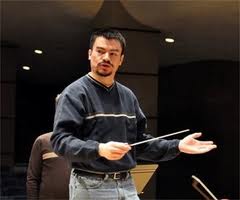|
Symphony
YOUTHFUL VIRTUOSITY ON DISPLAY AT USO'S MAY CONCERTS
by Peter Lert
Saturday, May 17, 2025
Symphony
MYSTICAL PLANETS AND LIVELY GERSHWIN ORTIZ AT FINAL SRS CONCERT
by Peter Lert
Sunday, May 4, 2025
Symphony
VSO'S CONCERT MUSIC OF TIME, MUSIC OF PLACE
by Peter Lert
Sunday, April 27, 2025
Choral and Vocal
VOCAL ELEGANCE AND FIRE AT THE 222'S RECITAL APRIL 26
by Pamela Hicks Gailey
Saturday, April 26, 2025
CANTIAMO SONOMA SINGS AN INSPIRED GOOD FRIDAY MOZART REQUIEM CONCERT
by Pamela Hicks Gailey
Friday, April 18, 2025
DRAMATIC SHOSTAKOVICH SYMPHONY CLOSES PHILHARMONIC'S 25TH SEASON
by Terry McNeill
Sunday, April 13, 2025
LARGE COLLEGE OF MARIN AUDIENCE GREETS STOPHER ARTISTRY
by Terry McNeill
Saturday, April 5, 2025
Chamber
FRISSON DELIVERS SHIVERS OF DELIGHT
by Abby Wasserman
Sunday, March 30, 2025
OLD AND MOSTLY NEW IN SRS MARCH CONCERT IN WEILL
by Peter Lert
Saturday, March 22, 2025
Symphony
TWO FORMIDABLE SYMPHONIES AND PURPLE MOUNTAINS AT SRS CONCERT
by Peter Lert
Sunday, February 23, 2025
|
 |
 Conductor Norman Gamboa |
APSC BRINGS NEW LIFE TO RENOVATED SRHS AUDITORIUM
by Terry McNeill
Saturday, October 20, 2012
In a memorable concert on Oct. 20, the American Philharmonic Sonoma County (APSC) opened a new season with a new music director and a new home in an historic Santa Rosa hall.
It was with some trepidation that old-time audience members, familiar with the Santa Rosa High School Auditorium from the Santa Rosa Symphony’s 30-year residence ending in 1982, arrived at the refurbished 900-seat venue. How would the “people’s orchestra” play in a hall famous for bright but indistinct acoustics? And would there be lengthy speeches and the national anthem as de rigueur at opening concerts? Surprisingly, the remarks of APSC President Steven Peterson and Conductor Norman Gamboa were pointed and brief. There was good music afoot, along with an unusual seating chart. The first violins were stage right, followed clockwise by the violas, cellos and second violins.
In the opening bars of Schubert’s two-movement Symphony in G (“Unfinished”), Mr. Gamboa fashioned a quiet set of chords that led to an expansive B Minor Allegro Moderato, the themes stated throughout by clarinetist Nick Xenelis and flutist Debra Scheuerman. Gamboa’s stick technique is sharply different from the consummate control of Bruno Ferrandis and Michael Tilson Thomas, and it's a more leisurely in direction, animated only rarely, but the results were well-shaped and balanced.
The concluding Andante featured warm and committed orchestral playing, supporting Anton Rubinstein's remark that Schubert was "eternal sunshine in music." The two main themes were deftly and beautifully announced by the cellos and basses, and the clarinet-oboe duet was captivating. Rich and subtle horn playing was heard from Eric Anderson and John Lounsbery. As with the Dvorak work on the second half, Mr. Gamboa conducted without score.
Continuing an evening replete with exemplary brass playing, horn soloist Meredith Brown played Strauss’s Concerto No. 1, Op. 11, with grace and easy virtuosity throughout all three movements, the first two linked without pause. Everything in the solo part was in good order, the strongest playing coming in the higher registers where the lyrical E-Flat Major notes sang out to the back of the hall. The subdued Andante and robust and extended Allegro featured Ms. Brown in a resolute “call and response” with the orchestra to dramatic effect. The half-full auditorium provided a substantial ovation.
The second half was devoted to Dvorak’s Eighth Symphony. The opening Allegro con Brio highlighted Anthony Blake’s resonant timpani playing and the lush string sections. Tuba player Floyd Reinhart and trombonists Jeff Barnard and Bill Welsh were stellar in this movement, paced carefully by Mr. Gamboa. The fugal sections provided dramatic interest and contrast. The lovely nostalgic waltz theme in the Allegretto Grazioso third movement was played elegantly, the honeyed clarinet lines from Mr. Xenelis and Ken Ward again standing out.
Trumpet players Tom Hyde and Philip Beard performed the finale’s fanfare as one, dramatically launching a great finale of visceral emotion. This Allegro, the most Slavic of the symphony, featured an extended solo by Ms. Scheuerman, the principal flutist. Mr. Gamboa expertly built the tension, and in the accelerated coda parts, the orchestra exploded in a cascade of gaiety.
How was the sound in the circa 1924 hall? The acoustics are not warm, but they are thankfully not as bright and diffuse as before the renovations. The reverb is fast, yet the sound is better focused than at the APSC’s old home at the Wells Fargo Center. The APSC can and will make music in its new venue.
|
